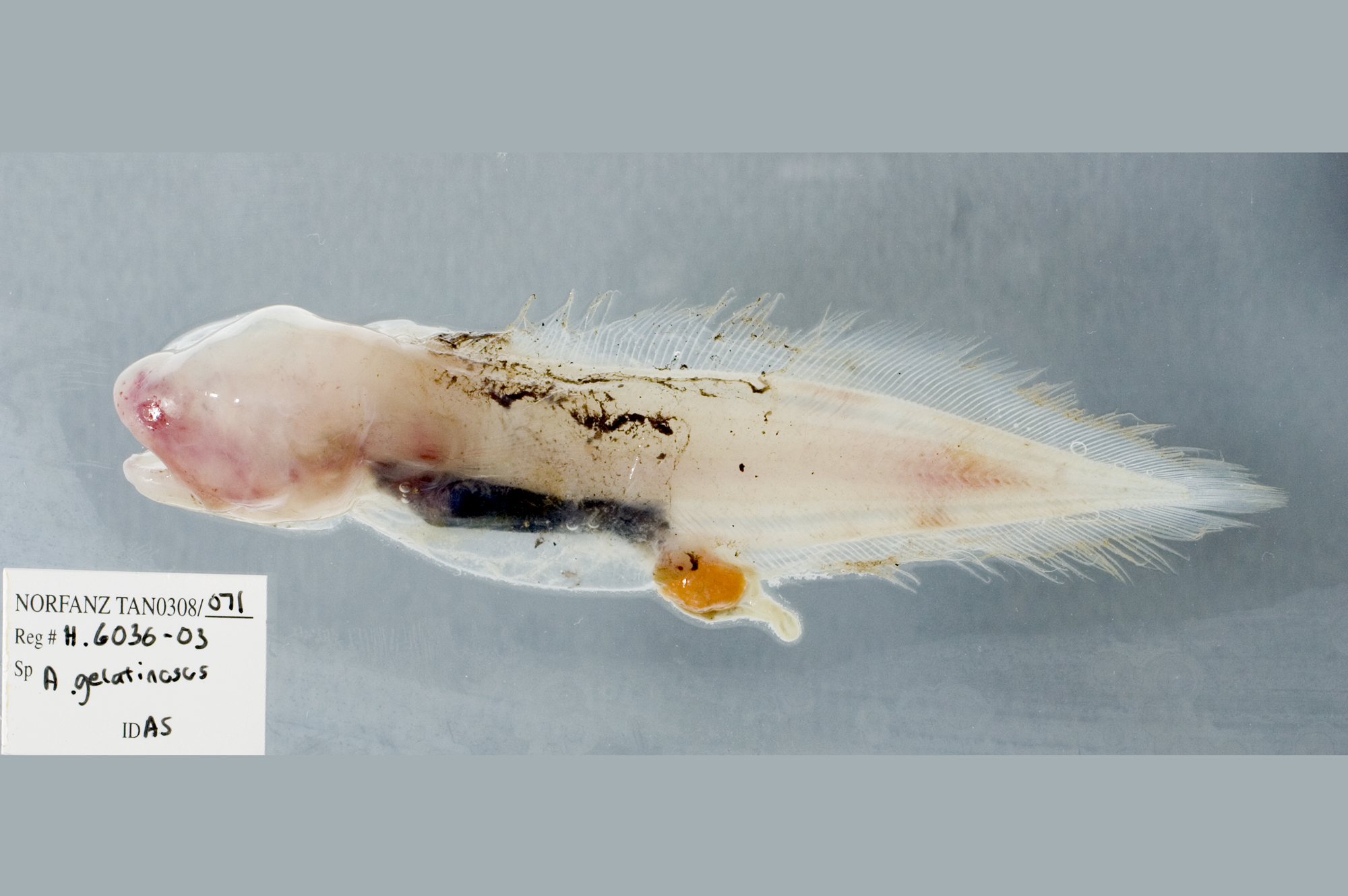- Classification
- ACTINOPTERYGII
- OPHIDIIFORMES
- BYTHITIDAE
- Aphyonus
- gelatinosus
Gelatinous Blindfish, Aphyonus gelatinosus Günther 1878

A Gelatinous Blindfish, Aphyonus gelatinosus, from the Lord Howe Rise in the Tasman Sea, May 2003, depth about 1930 m. Source: Kerryn Parkinson / NORFANZ Founding Parties. License: All rights reserved
Summary:
A pale cusk-eel covered in loose, transparent, gelatinous skin, with poorly-developed eyes, continuous dorsal, anal and caudal fins, and no scales, swim bladder or pyloric caecae.
Cite this page as:
Bray, D.J. 2019, Aphyonus gelatinosus in Fishes of Australia, accessed 06 Jul 2025, https://fishesofaustralia.net.au/Home/species/4070
Gelatinous Blindfish, Aphyonus gelatinosus Günther 1878
More Info
|
Distribution |
Off eastern Australia from off Cape York, Queensland, to off Nowra, New South Wales, and the Lord Howe Rise, SE of Lord Howe Island. Elsewhere the species is circumglobal in tropical and subtropical oceans and seas. It is bathydemersal, occurring on or near the seafloor at depths of about 625-2,560 m. |
|
Features |
Dorsal fin 106-116; Anal fin 65-68; Pectoral fin 17-18; Pelvic fin 1 ray; Caudal vertebrae 51-53, precaudal vertebrae 31-33; Gill rakers (long, first arch) 3-4. Body short, depth at anus >10% SL; eyes small or not externally visible; mouth almost horizontal; palatines edentate; dorsal, caudal and anal fins continuous; pectoral fin with short peduncle; vertebral centra in adults rectangular in lateral view. |
|
Biology |
The species is viviparous, and females produce relatively few large eggs, with rather large larvae found on or near the seafloor. Little is known of the habitat and ecology of this species. |
|
Species Citation |
Aphyonus gelatinosus Günther 1878, Ann. Mag. Nat. Hist. 5 2(2, 22, 28): 22. Type locality: off Cape York, Queensland, Challenger station 184, 12°08'S, 145°10'E, depth 1400 fathoms. |
|
Author |
Bray, D.J. 2019 |
|
Resources |
Gelatinous Blindfish, Aphyonus gelatinosus Günther 1878
References
Günther, A. 1878. Preliminary notices of deep-sea fishes collected during the voyage of H.M.S. Challenger. Annals and Magazine of Natural History 5 2(2, 22, 28): 17-28, 179-187, 248-251
Knudsen, S. 2015. Aphyonus gelatinosus. The IUCN Red List of Threatened Species 2015: e.T57453548A60774385. http://dx.doi.org/10.2305/IUCN.UK.2015-4.RLTS.T57453548A60774385.en. Downloaded on 19 July 2016.
Nielsen, J.G. 1969. Systematics and biology of the Aphyonidae (Pisces : Ophidioidea). Galathea Report 10: 1-90 figs 1-57 pls 1-4 PDF Open access
Nielsen, J. 1986. Aphyonidae, pp. 1167-1171. In: P.J.P. Whitehead, M.-L. Bauchot, J.-C. Hureau, J. Nielsen & E. Tortonese (eds) Fishes of the North-eastern Atlantic and the Mediterranean, UNESCO, Paris.
Nielsen, J.G. 1997. Deepwater ophidiiform fishes from off New Caledonia with six new species. In, Séret, B. (ed.) Résultats des Campagnes MUSORSTOM, v. 17. Mémoires du Muséum National d'Histoire Naturelle. Paris 174: 51-82
Nielsen. J.G. 1999. Families Carapidae, Ophidiidae, Bythitidae, Aphionidae. pp. 1978-1985 in Carpenter, K.E. & Niem, V.H. (eds) The Living Marine Resources of the Western Central Pacific. FAO Species Identification Guide for Fisheries Purposes. Rome : FAO Vol. 3 pp. 1397-2068.
Nielsen, J.G., Cohen, D.M., Markle, D.F. & Robins, C.R. 1999. Ophidiiform Fishes of the World. An annotated and illustrated catalogue of pearlfishes, cusk-eels, brotulas and other ophidiiform species known to date. FAO Fisheries Synopsis No. 125 Vol. 18. 178 pp.
Nielsen, J.G., Pogonoski, J.J. & Appleyard, S.A. 2019. Aphyonid-clade species of Australia (Teleostei, Bythitidae) with four species new to Australian waters and a new species of Barathronus. Zootaxa 4564(2): 554–572, http://dx.doi.org/10.11646/zootaxa.4564.2.12.




